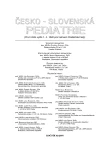-
Medical journals
- Career
Changes in Iodine Supplementation after Eradication of Iodine Deficit and Their Possible Causes. A Randomized Study of Children Population in Two Regions of the Czech Republic with a Time Lapse of 5 Years. First Publication of the Results
Authors: J. Čeřovská; R. Bílek; M. Dvořáková; H. Zamrazilová; P. Hoskovcová; M. Vosátková; V. Zamrazil
Authors‘ workplace: Endokrinologický ústav, Praha ředitel doc. MUDr. V. Hainer, CSc.
Published in: Čes-slov Pediat 2007; 62 (2): 65-72.
Category: Original Papers
Overview
Introduction:
Iodine, as well as a series of other elements important for heath, occupies a certain optimal dose range of daily intake. It is therefore important for humans to avoid shortages as well as excessive supply. In the second half of 90ties the previous shortage of iodine has been significantly adjusted. The evolution of changes in the population supply with iodine should be further monitored or their causes explored. Objective: to detect changes in iodine in urine (“ioduria”) of children and to look for causes of these changes in the nutritional habitsMethods:
In 1999, 2000, 2004 and 2005 the authors examined a representative cohort of 1209 children at the age of 6, 10 and 13–17 years, living permanently in the region of Jablonec nad Nisou or Příbram. Ioduria as a reflection of iodine intake was determined by the combustion method on the basis of the Sandell-Koldhoff reaction. Information on possible nutritional sources or iodine (sea fish, milk, salting, eggs, and mineral water) was obtained by questionnaire and guided interview.Results:
In the course of 5 years there was significant increase in the mean iodine levels in urine from 140 ± 3.69 to 221 μg/l ± 8.66. In both regions there was a significant increase in the frequency of persons with excessive ioduria (above 300 μg/l): it was from 0 to 24% in the Jablonec region and from 0 to 32% in children from the Příbram area. In the latter region there was a significant decrease in the frequency of children in the category of optimal iodinuria (100 to 300 μg/l) from 86 % in the year 2000 to 53.5 % in 2005.
The prevalence of insufficient iodine intake (up to 50 μg/l) was in the range of 0.7 to 2%. The changes in this category were not statistically significant. In the tested nutritional changes, which could influence the level of iodine in urine, the authors noticed a significant increase in the consumption of mineral water containing iodine: their consumption increased in the course of 5 years from 12% to 15% in the Jablonec region and from 33% to 49% in the Příbram region.
A significant increase of sea fish consumption the day preceding the examination was encountered only in children in the Příbram region. In the course of five years there was also a significant decrease in the number of children exposed to thiocyanates from cigarette smoke (stay in the smoke-polluted environment more than an hour a day). Multifactorial analysis of variance of four main nutritional iodine sources (consumption of milk, sea fish, eggs and salt) revealed that regular drinking of milk most significantly influenced ioduria in children. The children having not drunk milk displayed ioduria of 150 μg/l, whereas those who drank milk daily had ioduria of 187 μg/l. The difference was statistically significant at 95% level of significance.Key words:
urinary iodine, nutrition, children, regions of the Czech Republic
Labels
Neonatology Paediatrics General practitioner for children and adolescents
Article was published inCzech-Slovak Pediatrics

2007 Issue 2-
All articles in this issue
- Teratogenic Phenylketonuria-related Embryopathy
- Changes in Iodine Supplementation after Eradication of Iodine Deficit and Their Possible Causes. A Randomized Study of Children Population in Two Regions of the Czech Republic with a Time Lapse of 5 Years. First Publication of the Results
- Bone Marrow Transplantation in Children – Parents’ Point of View
- Bone Marrow Transplantation in Children – Medical Staff Point of View
- Multiple Intracranial Complications of Pansinusitis in Children
- Continual Monitoring of Electric Brain Activity in Newborns (aEEG – Amplitude Integrated EEG)
- Heart Rate Variability in Neonatal Period
- Czech-Slovak Pediatrics
- Journal archive
- Current issue
- Online only
- About the journal
Most read in this issue- Multiple Intracranial Complications of Pansinusitis in Children
- Continual Monitoring of Electric Brain Activity in Newborns (aEEG – Amplitude Integrated EEG)
- Bone Marrow Transplantation in Children – Parents’ Point of View
- Teratogenic Phenylketonuria-related Embryopathy
Login#ADS_BOTTOM_SCRIPTS#Forgotten passwordEnter the email address that you registered with. We will send you instructions on how to set a new password.
- Career

